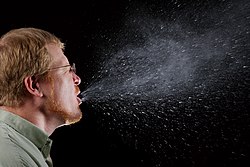Defensive breathing reflexes
Defensive breathing reflexes protect the respiratory system from disruption that can occur when inhaling toxic or highly irritating substances. It serves primarily to keep the airways free. The basic defensive reflexes include: Kratschmer's apnoea reflex, sneezing, cough, etc.
Apnea reflex[edit | edit source]
Apnoea reflex is a respiratory arrest (apnoea) caused by an irritation of the olfactory apparatus by a severely irritating substance. In addition, reflex apnoea prevents aspiration of food when swallowing.
- Centripetal pathway: fibres of n. trigeminus from the nasal mucosa or fibres of n. olfactorius.
- Centre: respiratory centre (in the brainstem).
- Centrifugal pathway: fibres leading to the motoneurons of all respiratory muscles.
Sneezing[edit | edit source]
Sneezing (sternutatio[1]) arises from irritation of the receptors of the nasal mucosa. Maintains passage nasal cavity. A larger amount of mucus irritates receptors and after a large inhalation with a strong exhalation, the cavity is released.
- ''Centripetal pathway: same as apnoea reflex.
- Centrum: respiratory centre.
- Centrifugal path: same as for the coughing reflex.
Cough[edit | edit source]
Cough (tussis) helps to keep loose passage airways. It is caused by the accumulation of mucus or inhalation of a foreign body that irritates receptors in the area of the [larynx]] and bifurcation of the trachea. After a large inhalation with a closed vocal slit, the pressure in the chest cavity rises, and after opening the slit, air flows along with the foreign body through the oral cavity away.
- Centripetal orbit: vagal fibres in n. laryngeus superior and sensory fibres in n. trigeminus.
- Centre: respiratory center.
- Centrifugal orbit:
- motor fibers leading from the respiratory trunk to spinal motoneurons that control the intercostal muscles;
- motor fibers n. vagus, controlling the vocal slit.
Other reflexes[edit | edit source]
- Among the defensive breathing reflexes, some authors include hiccups and yawning.
Hiccups[edit | edit source]
Hiccup (singultus) arises from convulsive contractions diaphragm. It is induced reflexively (by irritation of the diaphragm) or materially (by direct irritation of the respiratory center). The characteristic hiccup sound is produced by the rapid intake of air into the lungs, which closes epiglottis.
Yawning[edit | edit source]
Yawning (oscitatio[2]) is a common reflex characterized by prolonged inhalation through the open mouth followed by a short exhalation. It is not given special physiological importance, but is mainly associated with fatigue, cooling of the brain or empathy[3].
Links[edit | edit source]
Related Articles[edit | edit source]
Resources[edit | edit source]
- KITTNAR, Otomar. Lékařská fyziologie. 1. edition. Grada, 2011. 790 pp. ISBN 978-80-247-3068-4.
- TROJAN, Stanislav. Lékařská fyziologie. 3. edition. Grada, 1999. ISBN 80-7169-788-5.
- MYSLIVEČEK, Jaromír. Základy neurověd. 2. edition. Triton, 2009. 390 pp. ISBN 978-80-7387-088-1.
Ref[edit | edit source]
- ↑ MEDICAL DICTIONARY,. Sternutatio [online]. [cit. 2018-06-25]. <https://medical-dictionary.thefreedictionary.com/sternutatio>.
- ↑ WIKIPEDIA,. Oscitatio [online]. [cit. 2018-06-25]. <https://la.wikipedia.org/wiki/Oscitatio>.
- ↑ GUPTA, Sharat – MITTAL, Shallu. Yawning and its physiological significance. Int J Appl Basic Med Res [online]. 2013, vol. 3, no. 1, p. 11-5, Available from <http://www.ijabmr.org/text.asp?2013/3/1/11/112230>. ISSN 2229-516X.


